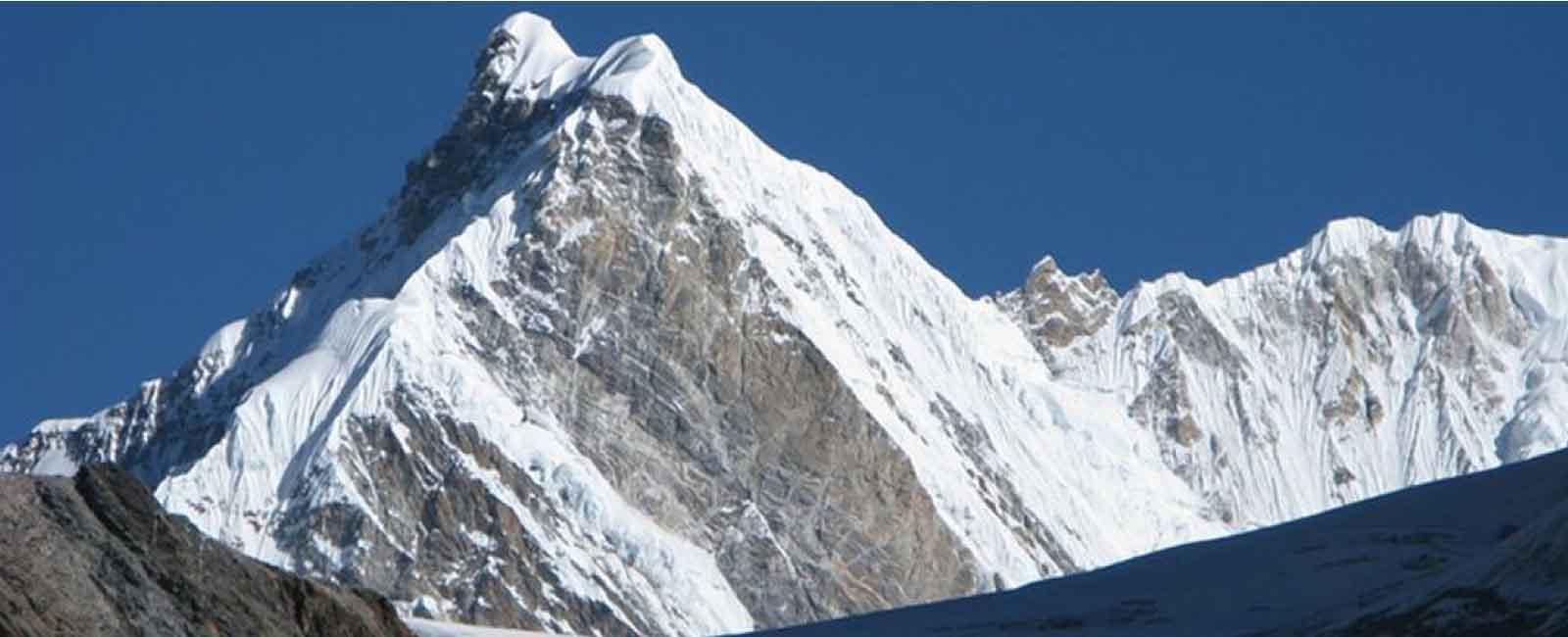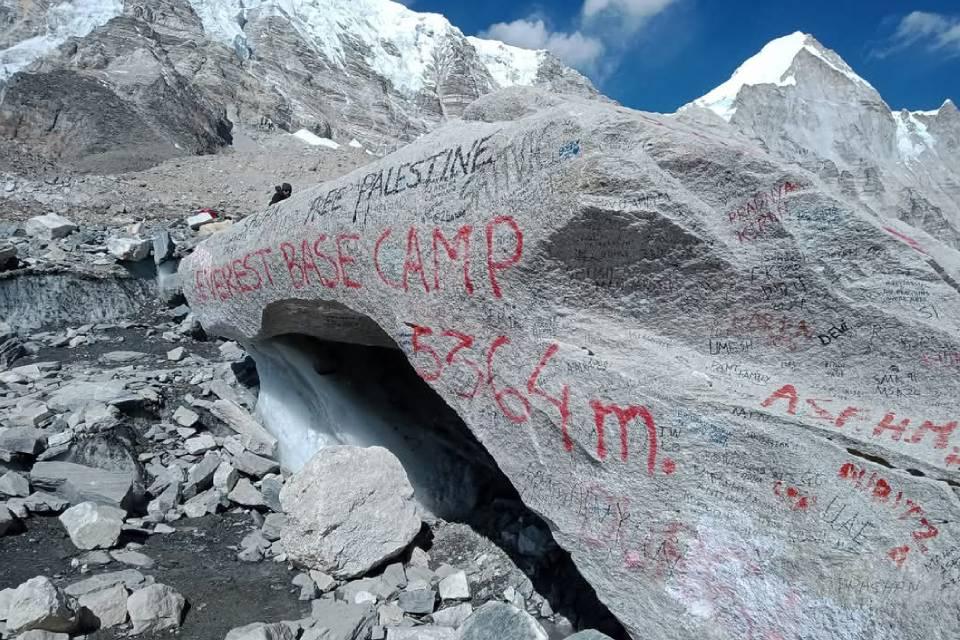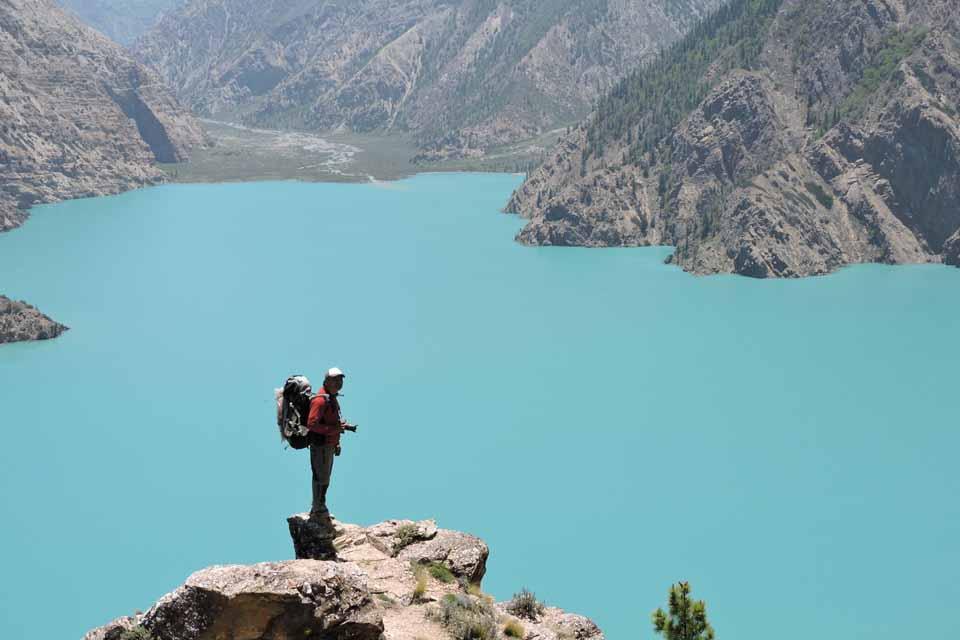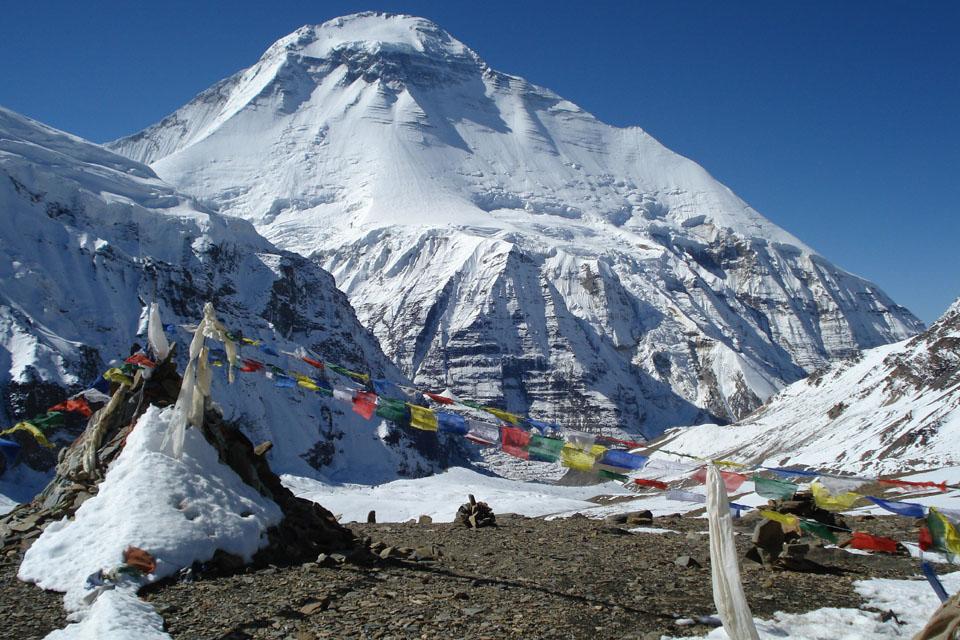Api Base Camp Trek
Trip at a Glance
Api Himal trek is a little-known trekking route located in western Nepal. The trek will take you to the base camp of Api Himal. Api Himal (7,132 m) is the highest mountain in the Far- West region of Nepal in Darchula district. Trekking to Api is a moderate grade trek and provides spectacular views of Api Himal and it’s surrounding peaks. Api Himal is yet to be climbed though a climbing permit is provided by the Nepalese government.
The trek to Api Himal starts the next day after a flight from Kathmandu to Dhangadhi from a small town in Latinath. The trekking trail takes trekkers through remote villages, lush forests, and alpine meadows before reaching the base camp of Mt. Api at an altitude of around 5,100 meters. You will be captivated by the spectacular panoarama of Kap Chuli Peak (6680 m), Nampa(6611 m)-I,II & III, Bobaya Chuli (6808 m), Jethi- Bahurani (6850 m).
The trek is fit for anyone with a good level of fitness and get used to camping treks since no lodges are available on the trekking trail as yet. If so, then be prepared to explore the pristine and most isolated, and least developed locations of Nepal, far from the usual tourist crowds.
Api Base Camp Trek Highlights
- Trek through the off-the-beaten-trails leading to Api Himal Base Camp.
- Explore the wilderness trekking location of Nepal.
- Experience the breathtaking vistas of Mt. Api (7,132 m) & other snow-capped summits, including Mt. Kapchuli (6,850 m), Mt. Rajama (6,537 m), & Mt. Thado Dhunga Tuppa (5,368 m), up close.
- Witness local authentic culture, and traditions.
- Explore the holy lake of Kali Dhunga.
Itinerary
Day 01: Arrival in Kathmandu (1,300m)
Day 02: Fly from Kathmandu to Dhangadhi (109m/1 hr & 15 min flight)
Day 03: Drive from Dhangadhi to Gokuleshwar (8 hrs drive)
Day 04: Drive from Gokuleshwar to Latinath (1,004m/2 hrs) & trek to Paribagar (1,770m/1 hr)
Day 05: Trek from Paribagar to Makarigaad (1,470m/ 5 hrs)
Day 06: Trek from Makrigaad to Siti (2,254m/8 hrs)
Day 07: Trek from Siti to Domal (2,950m/7 hrs)
Day 08: Trek from Domal to Dhaulo Odar (Lower Api Base Camp) (3,548m/5 hrs)
Day 09: Trek from Daulo Odar to Api Base Camp/Pilkandah (3,861m) & back to Daulo Odar
Day 10: Trek from Daulo Odar to Siti (2,258m/6 hrs)
Day 11: Trek from Siti to Makarigaad (1,470m/6 hrs)
Day 12: Trek from Makarigadi to Latinath (4 hour) & drive to Gokuleshwar (2 hrs)
Day 13: Drive from Gokuleshwar to Dhangadhi (9 hrs)
Day 14: Fly from Dhangadhi to Kathmandu (1,300m/1 hr & 15 min flight)
Day 15: Final Departure
Arrive in Kathmandu, and one of our representatives will receive you and then transfer you to your hotel in Kathmandu. The rest of the time is free to explore the city where your hotel is located, which is usually at Thamel, the popular tourist hub in Kathmandu, where every needs and facilities for tourists are located like hotels, pubs, restaurants, department stores, trek gear shops, etc. Or you can simply rest at your hotel if you are jet-lagged and get ready for an amazing Himalayan trek.
We will have breakfast at the hotel before being driven to the airport to catch a flight to Dhangadhi. The Kailali District's capital is Dhangadhi. From Kathmandu, it takes about one hour and fifteen minutes to go to Dhangadhi. If the sky is clear, you can take in a stunning aerial perspective of the ground below. You will be driven from the Dhangahi airport to the tourist-standard accommodation that has been reserved for you. After checking in at the hotel, we will go to Jokhar Lake and Botanical Garden in Dhangadhi.
We will drive from Dhangadhi to Gokuleshwar today, leaving the Terai plains in the far western area of Nepal and heading toward the country's hilly terrain. We'll go on the Mahakali Highway from Dhangadhi to Gokuleshwar in around 8 hours. We will travel 3–4 hours uphill to reach Dadeldhura, popularly known as the Queen of Hills, which is located in the far western part of Nepal.
The bus will proceed on a winding road through the highlands of far western Nepal after eating lunch in Dadeldhura. Along the way, you'll see stunning vistas of the Himalayas, the Chamelyia Valley, the river, and small, traditional communities of people. We shall arrive in in the late afternoon in Gokuleshwor. We'll spend the night in a very modest lodge in Gokuleshwar.
We will travel to Latinath today after breakfast in Gokuleshwar. The hike to the Api Base Camp begins at Latinath. From Gokuleshwar, it takes about two hours to get to Latinath. The largest hydropower station in the far-western region of Nepal is located along the route to Latinath, which is located along the Chameliya River. Our long journey to Api's base camp starts at Latinath. However, today's journey would only take us from Latinath to Paribagar, a picturesque settlement at 1,770 meters above sea level. We must trek uphill for an hour to reach Paribagar. You can stroll around the village in the evening. In Paribagar, homestays will be arranged for dinner and lodging.
We left Paribagar after breakfast to travel to Makrigadi. We will walk via a traditional village in the mid-hills that features old agricultural terraces, traditional stone homes, and unspoiled countryside in Nepal's far-western area. After lunch, the hike to Makrigaad continues along the Chameliya River through subtropical forest, subalpine woodland, and oak, hemlock, and rhododendron woods. We will reach Markigadi, a stunning village, after roughly two hours of climbing.
The day's trekking begins with a brief, sharp ascent to the Chameliya River after breakfast in Makrigaad. After crossing the river, we will ascend the gorge and move on to the settlement of Pato while taking in the breathtaking scenery. From Pato on, the ascent is gradual but steady. After reaching the final hill, we'll continue on this steadily ascending trail until we reach the picturesque town of Siti, which is reached after a relatively short and straightforward descent. We don't get to our overnight location until after roughly eight hours of walking.
We left Siti for our destination today, Domal, after breakfast. The first part of the journey from Siti to the settlement of Khayekot is downhill. It's a stunning town situated beside the Chameliya River. The last permanent habitation in the Chameliya Valley is known to have been in Khayekot. At Khayekot, we will have a lunch stop. We will gradually rise to Domal after lunch. From Siti, it will take us around 7 hours to walk to Domal. Domal, where the rivers Chameliya and Rokap converge, is revered much in this area.
After breakfast at Domal, the hike for today begins with a challenging ascent. The trail is rather simple until you get to the summit and continue through woodland and open meadows. We will eventually arrive at an open grassland surrounded by steep mountains, a rhododendron forest, and a few small caves after about five hours of walking. We set up camp here for the night in this magnificent location.
The most anticipated day of the entire trek is today. We arrive at Mount Api's base camp today. We won't leave for the Api Base Camp after breakfast without packing lunch. From Daulo Odar, a 2.5-hour ascent will bring us to a sizable open plateau ringed by mountains. The Api Base Camp is on this plateau. The biggest views of Mt. Api (7,132m), Mt. Nampa (6,929m), and Mt. Bobaye (6,808m) welcome hikers to Api Base Camp as we approach the plateau.
After taking in the captivating vista, we'll travel to the Chameliya River's source and stop by a nearby, modest temple constructed by the locals. After lunch, we'll visit the revered Lake Pilkandaha. We will now head back to Daulo Odar for the night after exploring the lake.
After breakfast, we started our drive back to Siti, bidding adieu to the stunning Mt. Api and the area around Daulo Odar. We will first arrive at Khayekot settlement after the downhill stroll. Following lunch at Khayekot, we will ascend a hard hill to settle Siti. We will pass lovely green hills and agricultural terraces along the route.
The day's trek starts with a climb to the ridge above Siti after breakfast in Siti. The trail now meanders around the ridge, passing through a forest, farmland, and a sparsely populated area. We'll also have an opportunity to take in the sights of the Himalayas along the route. After stopping for lunch in Pato, we'll continue walking steadily downward until we reach Makarigaad. You can spend the evening exploring Makrigaad's settlement if you have the time and desire.
We will hike to Latinath after breakfast at Makarigadi. After passing Paribagar, a four-hour downhill hike will lead us to Latinath. The climb to Latinath is extremely enjoyable and not too strenuous. If time allows, we'll also take a quick trek up to the Hindu temple that's right above Latinath once we get there. If time doesn't allow, we'll take a bus to Gokuleshwar right away. We will arrive in Gokuleshwar after a lovely bus ride of roughly two hours. We will be taken from the bus station to a basic lodge in Gokuleshwar for the night.
We get going early today. After an early breakfast, catch a bus from Gokuleshwar to Dhangadhi. By lunchtime, the bus arrives in Dadeldhura after travelling through picturesque green hills with terrace farms, hamlets, and a small roadside teahouse. We'll have lunch at Dadeldhura, have a short break, and then go along the Mahakali Highway in the direction of Dhangadhi. After a leisurely 9-hour trip, we will arrive in Dhangadhi in time for dinner and an overnight stay. The night will be spent in a Dhangadhi hotel of tourist standard.
We will be taken to the airport to catch a flight to Kathmandu after breakfast at Dhangadhi. After a leisurely, picturesque flight of around an hour and fifteen minutes, the aircraft lands at Kathmandu's airport. You will be driven from the airport to the hotel in Kathmandu. The remaining day can be used to relax at the hotel or explore Kathmandu.
The trip concludes, and our office representatives will take you to the international airport in Kathmandu to catch your onward flight to your next destination or fly back home. You need to be at least 3 hours prior to your flight time at the airport.
Thank you for visiting Nepal and we hope your Himalayan Holiday has come true.
Have a safe flight back home!
What is included?
- Airport pick-up and drop services.
- Hotel accommodations in Kathmandu with breakfast.
- Kathmandu – Dhangadhi –– Kathmandu round airfares.
- Hotel accommodations in Dhangadhi & Gokuleshwar.
- All surface transfers by a local bus or jeep.
- All trekking accommodation (in tented camps) with breakfast, lunch & dinner.
- Personal insurance for crew members.
- Guide, porters, kitchen staffs and helpers wages for the trekking period.
- Four seasonal sleeping bag (to be returned after trip completion)& Marron duffel bags.
- A comprehensive medical kit (will be carried by the trekking guide).
- Required Trekking Permit fee & TIMS Card.
- Farewell dinner with live Nepalese cultural program.
- All government and local taxes.
What is not included?
- International airfare.
- Lunch & dinner In Kathmandu.
- Nepal entry visa fee – Visa can be obtained upon your arrival at the Tribhuwan International Airport in Kathmandu. (USD30 for 15 days)
- Personal travel insurance.
- Emergency rescue evacuation (to be covered by the client's travel insurance).
- Excess baggage charges (luggage allowance for domestic airlines in Nepal is 15 kgs.).
- Other expenses of personal nature (phone calls, laundry, battery recharge, extra porters, bottle or boiled water, shower etc.)
- Cost incurred due to the addition of extra days or change in the real course of the itinerary because of bad weather conditions, political turmoil or any other unforeseen contingencies.
- Bar bills, alcoholic drinks & beverages.
- Tips for guides, porters & crew (Tipping is expected).
Route Map
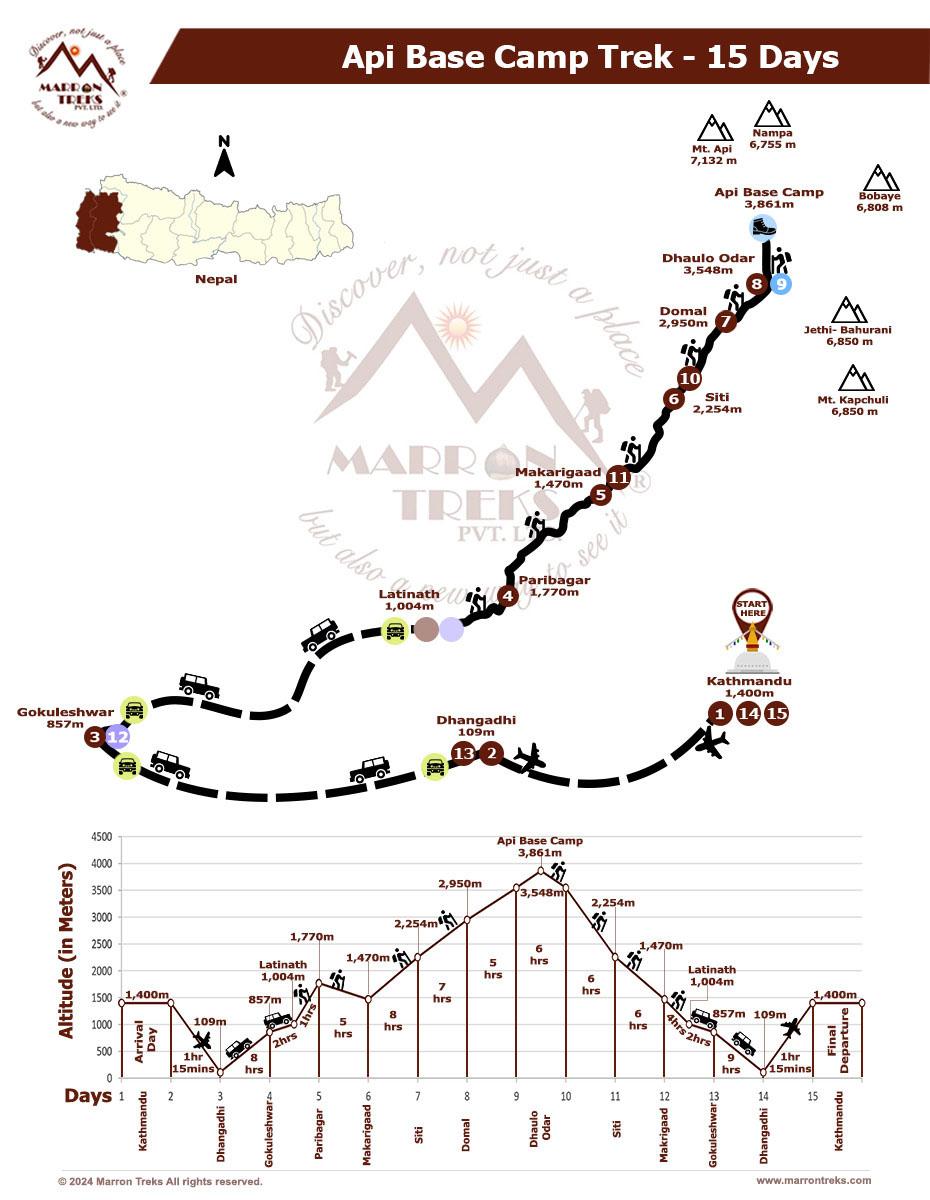
Trip Info
Accommodation
While you are in Kathmandu, we opt to accommodate you in 4- or 5-star hotels like Hotel Royal Singhi (4-star), Hotel Manaslu (4-star), Radisson (5-star), Yak & Yeti (5-star), or similar. During the trek, your primary accommodation will be tents. These are typically high-altitude, double-walled tents for better insulation and weather protection. You'll camp in designated campsites along the route. These are chosen for scenic beauty, flat ground, and access to water sources. Your trekking crew will set up tents that include your own personal tent, dining tent, toilet tent and staff tent.
Meals
We never compromise the quality of food or the health of the trekkers as well as the crew members. Expect meals packed with carbohydrates and protein prepared by our trained cook to provide sustained energy for long trekking days. Think along the lines of porridge, pasta, noodles, spaghetti, French fries, soups, and dehydrated meals.
Acclimatization
Altitude sickness is a serious risk while trekking in the Himalayas. It's important to acclimatize properly by spending a few days at lower altitudes before heading higher. By spending time at lower altitudes before pushing higher, your body has time to adjust. Our trekking packages have enough acclimatization days planned where you'll be spending a day or two at lower altitudes, allowing your body to adjust to the increasing altitude.
Drinking water
You can fill your bottle with boiling water. To make water drinkable, you can use water purification tablets too. But, due to hygienic issues, you should avoid drinking water from taps, rivers, or wells in trekking areas.
Communication
Our office in Kathmandu is in constant communication with your trek guide. In Kathmandu, you can purchase a local sim card for communication purposes. At high elevations, the mobile signal might not be as strong, though.
Luggage
Our porters are paired with one trekker for every two hikers, and one porter can safely carry 30 kg maximum weight. Therefore, we advise you to fill your duffle bag not more than 15 kg with your belongings. You may carry a small backpack with your valuables and informational documents. The things you are not taking along on the trek can be stored in a hotel in Kathmandu free of cost.
Typical Trek Day
Mostly your trek day starts with breakfast at 7-8 am, followed by a 3-4 hour morning trek. Lunch break is around an hour, then you continue trekking to your destination for the day. After reaching the teahouse lodge, you can relax, explore nearby areas, and enjoy dinner at 6-7 pm. Evenings involve socializing, a trek briefing, and leisure activities before bed.
Travel Insurance
It is advised that you arrange your travel insurance before leaving your homeland. The main thing is to make sure that your insurance covers you for both- medical and evacuation costs. Having travel insurance with you makes your trip secure and hassle-free.
Our Guides
Guides play a significant role during the trek. They are the ones who literally decipher the trekking codes for you so that you can actually connect with nature, culture and people along the way. We have helpful and dedicated trekking guides who are very well-versed in the culture, life patterns and every single detail pertaining to the trek region you are traveling in. Thus, in the company of our professional Sherpa guides, your trek becomes not only entertaining but also equally informative.
Porter and Staff Care
When it comes to high-altitude trekking, porters and staff members make up a pivot. Marron Treks ensures that all the porters and staff members going to high altitudes are provided with adequate clothing and equipment. All our field staff are covered by insurance.

